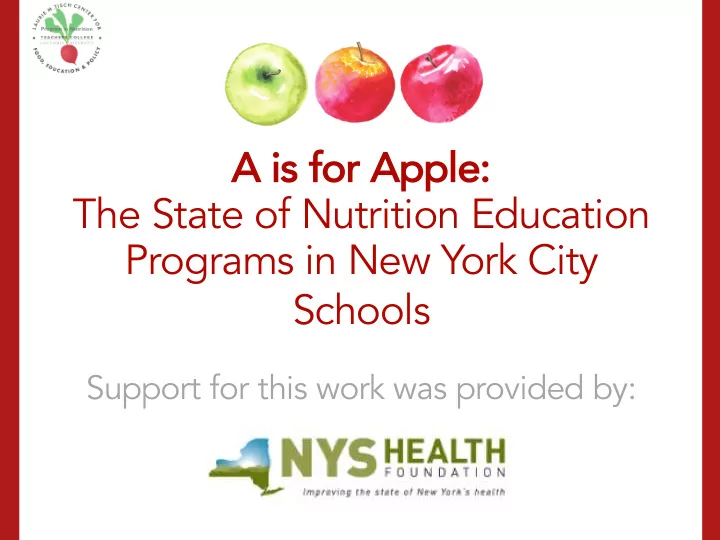

A A is fo for Apple: The State of Nutrition Education Programs in New York City Schools Support for this work was provided by:
Teaching food and nutrition might be viewed as the single most important educational activity of a society; if persons do not learn to obtain and consume food so as to sustain themselves and their dependents, all other learnings are irrelevant . —Dr. Joan Dye Gussow
The Tisch Food Center cultivates research about connections between a just, sustainable food system and healthy eating, and translates it into recommendations and resources for educators, policy makers, and community advocates. The Center focuses on schools as critical levers for learning and social change.
Nutrition Education in Schools
What did we do? Landscape of nutrition education programs • (NEPs) in New York City schools during the 2016–17 school year. Characteristics and distribution of • organizations and the NEPs they operate. Searchable online database of NYC NEPs •
Why did we do it? Give schools, NEPs, funders, and policy makers data and recommendations to ensure ALL NYC students have access to great nutrition education
The Nutrition Education Programs in New York City Schools Landscape: Key Findings
Federal, State, and City Policies UPDATE!! Sc Scho hools
Organization Type
Evaluation Figure 5.10: Conduct Evaluation
• Foundation and program fees are the most common NEP funding sources. • the majority of NEPs. • NEPs are rarely available to students in languages other than English. • greatest daily challenges for organizations operating NEPs. NEP Start Year Figure 6.1: NEP Start Year – 31 –
NEP Funding Sources Figure 6.4: NEP Funding Sources Figure 6.5: School Payment for NEP ** * 58 of 101 programs provided data ** “Private donors” was the most common “other” response. We pulled these responses from “other” to create a new category. More NEPs than noted here may receive funding from “private donors.”
NEP Activities Figure 6.7: NEP Activities * 80 of 101 programs provided data
Academic Subjects NEPS Address Figure 6.8: Academic Subjects that NEPs Address * 76 of 101 programs provided data
NEP Languages Other than English Figure 6.10: NEP Availability in Languages Other than English * 80 of 101 programs provided data
NYC Schools with NEPs Figure 7.1: Schools with NEPs
Comparison: 2011-12 to 2016-17 Figure 7.2: Comparison of Elementary Schools with NEPs in 2011–12 and 2016–17
NEP Distribution by Borough Figure 7.3: NEP Distribution by Borough
NEP Distribution by School Type Figure 7.4: NEP Distribution by School Type
NEP Distribution by Poverty Rate Figure 7.5: NEP Distribution by School Poverty Rate
NEP Distribution by Race/Ethnicity Figure 7.6: NEP Distribution by Percentage of Students who are Black and/or Hispanic
How do we achieve 100% of students with access to great nutrition education?
Recommendations For schools • For funders and policy makers • For organizations that operate NEPs •
Next Steps Coordination : Create a network that coordinates nutrition education distribution, advocacy, evaluation, and resources. Investment : Build program and school capacity through funding, technical assistance, tools, and training. Collaboration : Amplify and align the unique roles of nutrition education programs, school community members, funders, advocates, and policy makers.
Nutrition Education Programs in NYC Schools – Searchable Database
School gardening, hands-on cooking, food justice education, health literacy - by any name nutrition education is more important than ever for students' health, academic achievement, and development as 21st century citizens. All New York City students should have access to great nutrition education.
Recommend
More recommend